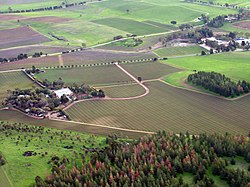Barossa Valley (wine)
| Wine region | |
 Aerial view of the Barossa Valley | |
| Type | Geographical indication (GI) |
|---|---|
| Year established | 1997[1] |
| Years of wine industry | Since 1843 |
| Country | Australia |
| Part of | Barossa Zone |
| Growing season | October–April |
| Climate region | Mediterranean |
| Heat units | 1710[2] |
| Soil conditions | Clay loam through to sandy[2] |
| Size of planted vineyards | 10,350 hectares (25,600 acres) |
| Varietals produced |
|
| No. of wineries | 150+[3] |
| Comments | Data from 2012[2] |
The Barossa Valley wine region is one of
Many of Australia's largest and most notable wineries are either headquartered or own extensive holdings in the Barossa Valley. These include such wineries as
In February 2011, South Australian Premier Mike Rann announced that special legislation would be introduced to protect the unique heritage of the Barossa Valley and McLaren Vale. Premier Rann said: "Barossa and McLaren Vale food and wine are key icons of South Australia. We must never allow the Barossa or McLaren Vale to become suburbs of Adelaide."[9] The Character Preservation (Barossa Valley) Act 2012 was subsequently passed by the South Australian Parliament.[10]
History

In December 1837 an expedition led Colonel William Light and was surveyed in 1839 by his assistant surveyor, William Jacob (1814–1902), as part of a wider survey of the Barossa region. Light chose the name in memory of the British victory over the French in the Battle of Barrosa, in which he fought in 1811. The name "Barossa" was registered in error, due to a clerical error in transcribing the name "Barrosa".[citation needed]
While most of Australia's wine industry was directly influenced by the involvement of the British, the Barossa Valley was shaped by the influence of German settlers fleeing persecution from the Prussian province of Silesia.
The early focus of the Barossa Valley wine industry was on the production of Riesling, a
By the late 20th century, the reputation of the Barossa Valley started to change as several small boutique varieties began earning critical acclaim for their Barossa Valley wines. In particular, Barossa Shiraz became so well known internationally that it was considered its own unique style of Syrah that was distinctive of the grape's expression in other regions like
Climate and geography

In general the Barossa Valley has a continental climate but its series of
Viticulture and winemaking

Most of the Barossa Valley makes extensive use of irrigation to supplement the region's low rainfall supply during the growing season. However, concerns about
The generally hot climate of the Barossa Valley usually means that the grapes become
Grapes and wine


While the Barossa Valley is most commonly associated with its signature grape variety of
Despite its reputation as a red wine region, the Barossa Valley does produce a large amount of white wine.
The plantings of Semillon in the Barossa Valley have evolved to develop its own unique pink-skinned
Notable wineries
- Charles Melton Wines
- Chateau Tanunda
- Chateau Yaldara
- Elderton Wines
- Hamilton's Ewell Vineyards
- Orlando Wines/Jacob’s Creek
- Penfolds
- Peter Lehmann Wines
- Rolf Binder
- Schiller Vineyards
- Seppelt Winery
- Teusner
- Torbreck Vintners
- Turkey Flat
- Wolf Blass
- Yalumba
References
- ^ "Barossa Valley". Australian Grape and Wine Authority. Retrieved 5 November 2014.
- ^ a b c "Barossa Valley Wineries". Wine Australia. Archived from the original on 9 October 2014. Retrieved 5 November 2014.
- ^ "Barossa". Barossa. Retrieved 9 April 2020.
- ISBN 1-56305-434-5
- ^ N. Parode "Barossa Valley: Australia's Flagship Wine Region" Into Wine, Accessed: 15 January 2010
- ^ ISBN 0-7892-0883-0
- ISBN 0307346358
- ISBN 0-451-18169-7
- ^ 891 ABC, 9 February 2011:"No Urban Sprawl into Wine Region"
- ^ "Character Preservation (Barossa Valley) Act 2012" (PDF). Government of South Australia. Archived from the original (PDF) on 12 November 2014. Retrieved 12 November 2014.
- ^ Max Allen, The History of Australian Wine: Stories From the Vineyard to the Cellar Room, Carlton, Victoria: Victory Books, 2012, p. 91
- ^ ISBN 0-671-68702-6
- ^ ISBN 1-84000-332-4
- ^ a b Australian Wine and Brandy Corporation "Barossa Valley Archived 25 November 2009 at the Wayback Machine" Official Site, Australian Government. Accessed: 13 January 2010
- ^ ISBN 0-7566-1324-8
